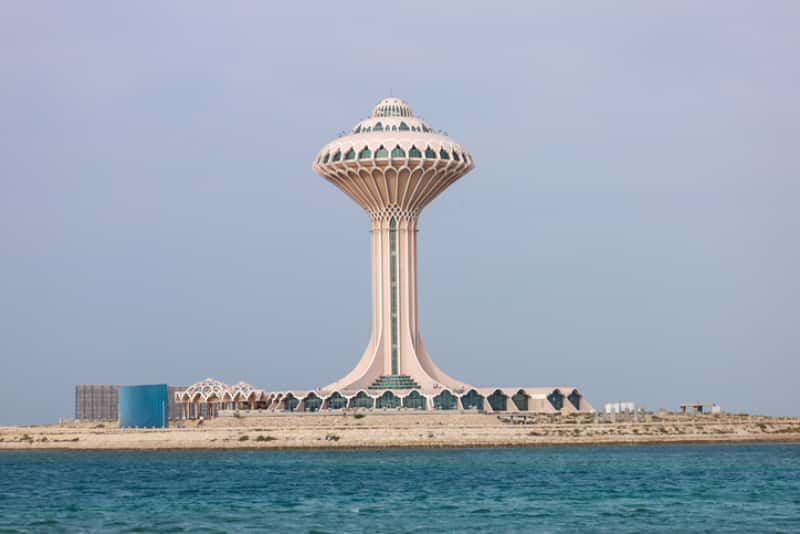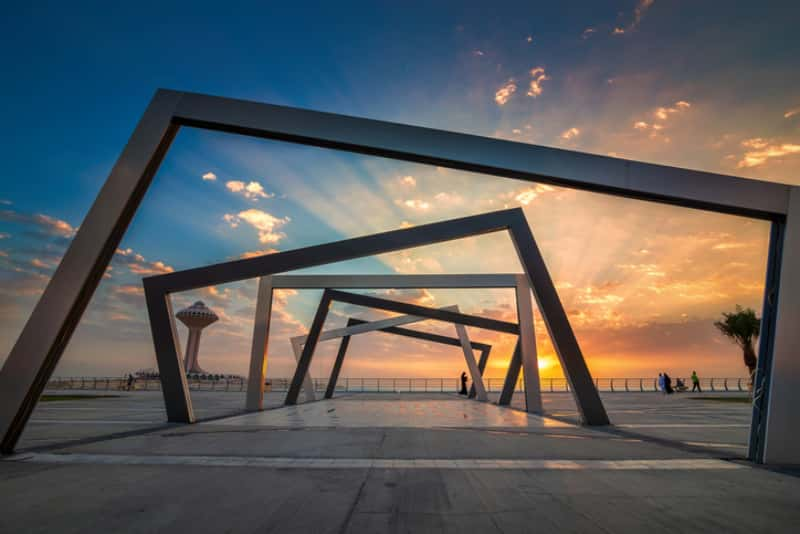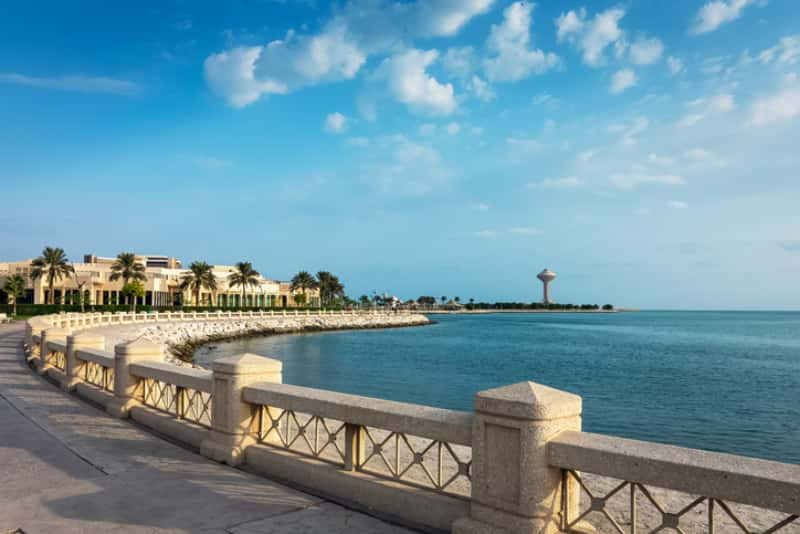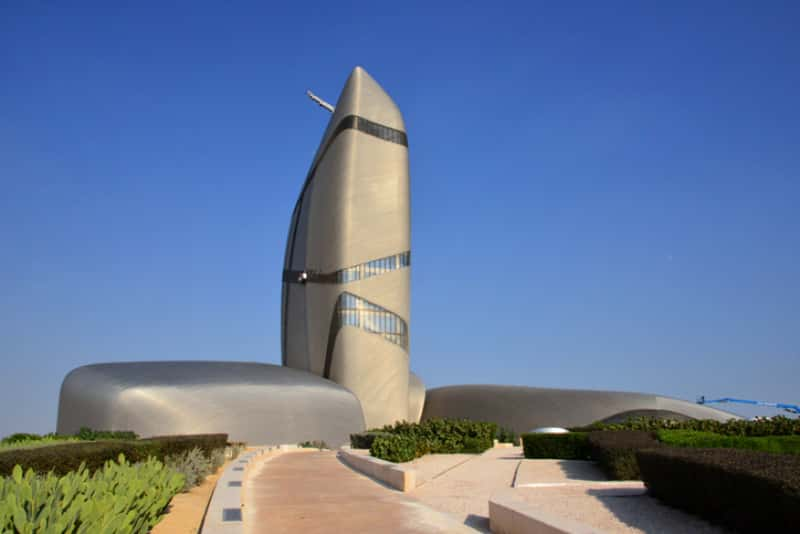Dammam City emerges as one of the most fascinating urban narratives in the Middle East's modern history. Founded as a simple fishing settlement in 1923, this coastal community underwent a remarkable metamorphosis after oil discovery in 1938 transformed its fortunes forever. The city now proudly serves as the capital of Saudi Arabia's Eastern Province, housing approximately 1.38 million residents within its boundaries. The greater Dammam metropolitan area—encompassing Dhahran and Khobar—stretches this population figure to an impressive 2.7 million inhabitants.
Visitors exploring this Eastern Province jewel encounter a city defined by superlative achievements and strategic significance. King Fahd International Airport claims the title of the world's largest airport by land area, sprawling across an extraordinary 780 km². Maritime commerce thrives through the King Abdul Aziz Sea Port, recognized as the Persian Gulf's second-largest port facility, processing cargo exceeding 2 million TEUs annually. The city landscape provides headquarters for Saudi Aramco, globally recognized as the world's largest oil company, a corporate giant that substantially contributes to the metropolitan area's formidable GDP of $78.8 billion.
Dammam's geographical positioning further enhances its prominence. The magnificent 28 km King Fahd Causeway connects the city directly to neighboring Bahrain, establishing Dammam as a vital nexus where commercial enterprises and cultural exchanges flourish together. This combination of industrial might, population density, and infrastructural development has firmly established Dammam as an indispensable component in Saudi Arabia's economic and cultural framework.
Dammam city possesses a singular character born from a rare fusion of geographical fortune, historical evolution, and forward-thinking development. Where other Middle Eastern urban centers might excel in isolated aspects of modern advancement or traditional preservation, Dammam stands distinctive through its exceptional blend of industrial prowess, cultural depth, and geopolitical significance on the world map.
Commanding a crucial position along the Persian Gulf coastline, Dammam functions as the administrative heart of Saudi Arabia's Eastern Province. This geographical advantage has naturally evolved the city into eastern Saudi Arabia's predominant commercial nucleus, simultaneously serving as the cornerstone of the nation's petroleum industry and a vital portal to the Arabian Gulf.
King Abdul Aziz Sea Port dominates the city's maritime profile, ranking the second largest on the Persian Gulf and eighth largest across the Middle East and North Africa region by cargo capacity. This nautical colossus processes an astonishing volume of maritime traffic—over 15,000 vessels delivering more than 13 million containers or 532 million tons of cargo yearly, firmly establishing Dammam as an indispensable import-export powerhouse.
Dammam's strategic positioning additionally placed it as the eastern railroad terminus connecting to Riyadh, linking the coastal territories with inland regions. The city's industrial footprint extends across an impressive 8 million square meters of dedicated industrial space throughout the metropolitan area, securing its status among the Middle East's premier industrial powerhouses.
Beneath Dammam's contemporary skyline and expansive suburbs—largely developed since the 1940s—beats the heart of Saudi Arabia's rich cultural heritage. This mesmerizing contrast between historic roots and forward-looking development creates an irresistible destination appeal.
Centrally located within this modern urban landscape stands the Heritage Village overlooking the waterfront, where exquisitely preserved architecture serves as a portal to treasured eras past. This cultural sanctuary features:
Simultaneously, Dammam embraces cultural progression through significant institutions like the Dammam National Museum and the nearby King Abdulaziz Center for World Culture (Ithra), housing an integrated complex of museum spaces, children's museum, library, cinema, theater, and exhibition galleries.
Dammam's geographical proximity to neighboring Gulf nations establishes a natural cultural intersection point. The engineering marvel of the 28 km (17 mi) King Fahd Causeway physically links Dammam to Bahrain, enabling continuous cultural exchange and solidifying regional connections.
These connections transcend mere physical infrastructure. The city's coastal position renders it particularly attractive to tourists seeking Persian Gulf beaches and convenient access to nearby eastern Arab nations, including the United Arab Emirates, Qatar, and Bahrain.
This geographical positioning fosters remarkable cultural diversity throughout Dammam, reflecting its function as a meeting ground between Saudi Arabia and the surrounding Gulf states. Such international character has cultivated an environment marked by receptiveness and warm hospitality, elevating Dammam to true jewel status along the Arabian Gulf shores.

Dammam beckons explorers with an array of remarkable destinations that display the full spectrum of its coastal charm and cultural depth. The city's landscape unfolds as a carefully curated collection of natural wonders and architectural achievements, each offering distinctive experiences for the curious traveler.
The Dammam Corniche extends gracefully along the Arabian Gulf shoreline, offering residents and visitors alike a serene waterfront retreat. Meticulously designed walking paths and cycling tracks weave through verdant green spaces perfectly suited for family gatherings and social congregation. This popular promenade maintains round-the-clock accessibility without entrance fees, allowing fitness enthusiasts to enjoy morning exercise routines while evening visitors savor the cooler coastal air.
South of Dammam lies the magnificent Half Moon Bay, named for its graceful crescent-shaped coastline. This spectacular 18-kilometer stretch of pristine white sand meets shallow, crystal-clear waters averaging just 7 meters in depth, creating ideal conditions for swimming and novice scuba diving enthusiasts. Beyond aquatic pursuits, the bay accommodates diverse recreational activities including volleyball, soccer, cycling, and equestrian adventures. Those seeking an authentic Arabian experience might partake in Kashta—traditional shoreline camping—under the vast desert sky.
Al Marjan Island stands as Saudi Arabia's pioneering artificial island, accessible via an impressive 1,800-meter bridge extending from the Dammam Corniche. Established in 1991 and encompassing 53,000 square meters, this human-made oasis features a commanding 30-meter observation tower at its heart, rewarding visitors with sweeping panoramic vistas. The island's careful landscaping integrates dunes, mangrove ecosystems, tropical palm species, and colorful floral displays, creating a tranquil haven away from urban congestion.
King Fahad Park holds the distinction of being the Kingdom's most expansive public garden, spanning more than 100 acres. This horticultural masterpiece showcases over one hundred varieties of trees, shrubs, and ornamental plants, complemented by artificial lakes, cascading waterfalls, and choreographed fountains. Families particularly appreciate the park's amusement section, which houses more than 25 recreational rides, masterfully balancing natural beauty with entertainment options.
Souq Al Hob—affectionately dubbed the "Love Market"—embodies centuries of Arabian mercantile tradition. Situated in central Dammam, this vibrant marketplace officially received its beloved moniker in 2019, formalizing six decades of popular usage. Operating daily from morning until late evening, the souq presents an enticing array of merchandise ranging from intricate gold jewelry to hand-woven carpets, traditional ceramics, and aromatic local spices. As darkness falls, the marketplace transforms with street performances and food vendors offering authentic regional delicacies.
Marina Mall combines retail therapy with breathtaking maritime views from its Gulf-facing location. The complex houses numerous retail establishments offering apparel, electronics, and souvenirs at competitive prices compared to neighboring commercial centers. Culinary options abound in the food court, where international restaurants serve diverse cuisines behind expansive glass walls framing spectacular seascapes. Families appreciate the mall's entertainment options, including a modern cinema and a dedicated children's recreation area.
Located in adjacent Dhahran, Ithra exemplifies Saudi Arabia's commitment to cultural advancement. Conceived by renowned Norwegian architectural firm Snøhetta and unveiled in 2016, this architectural triumph encompasses a 900-seat performance auditorium, a contemporary cinema, an extensive library housing over 315,000 volumes, multiple exhibition spaces, and diverse museums. The structure's remarkable design draws inspiration from subterranean oil-bearing geological formations, with its different levels conceptually representing temporal progression—past (below ground), present (surface level), and future (elevated sections). Recognized by Time magazine among the world's top 100 destinations, Ithra welcomed one million cultural enthusiasts in 2019 alone.

Daily life in Dammam weaves together contemporary amenities with deeply rooted cultural traditions, all set against the backdrop of an evolving urban center. Those contemplating a move to this Eastern Province capital—or simply curious about everyday existence here—benefit from understanding the city's housing landscape, career possibilities, and transportation infrastructure.
Dammam presents a residential tapestry characterized by thoughtfully designed neighborhoods featuring distinct separation between business districts and living quarters. Families particularly favor Al Rawdah, celebrated for its peaceful environment and accessible property values. Al Faisaliyah likewise attracts residents through its advantageous positioning amid numerous essential services.
Expatriates frequently opt for corporate-built compounds, a common residential solution in the region. These enclosed communities provide security alongside lifestyle amenities, including swimming facilities and fitness centers, though residents pay premium prices for these conveniences. Housing expenditures show a considerable range—centrally located two-bedroom apartments command between 20,000 and 30,000 SAR yearly, while peripheral areas offer similar accommodations for 15,000 to 25,000 SAR annually.
The economic foundation of Dammam centers predominantly on petroleum enterprises, with industry giant Saudi Aramco exercising significant influence across the sector. Salaries average approximately 132,179 SAR, though professional specialization creates substantial variation in compensation.
The current employment market particularly values specialized talent in healthcare and engineering disciplines. Notably, career opportunities extend beyond petroleum industries, with expanding prospects in digital technology. Global corporations including Siemens Energy, Google, Microsoft, and EPAM Systems maintain significant operational presence throughout the area.
Dammam has substantially upgraded its public transit infrastructure. The Eastern Region transportation initiative now serves numerous routes connecting Dammam, Khobar, Dhahran, and Qatif through an extensive network of 212 stations, utilizing 85 contemporary buses operating daily for 18 hours. Each vehicle accommodates 81 passengers and features specialized facilities for individuals with mobility requirements.
International connections flourish via King Fahd International Airport—globally distinguished as the most expansive airport by land area—linking the city with destinations spanning the Middle East, Asia, Africa, and the European continents. A comprehensive transit system approved in 2014 outlines ambitious development, including 50 kilometers of light rail, 110 kilometers of rapid bus corridors, and 350 kilometers of supplementary bus routes.

Dammam stands at the forefront of Saudi Arabia's ambitious national transformation. The Eastern Province capital leverages its established industrial foundation and strategic coastal position to catalyze economic evolution throughout the Kingdom. Few cities possess such potential to influence Saudi Arabia's developmental trajectory in the coming decades.
Dammam's robust industrial base positions it perfectly within Saudi Arabia's Vision 2030 framework. The petroleum infrastructure established over decades now serves as the bedrock upon which new economic sectors take root and flourish. Local planners have strategically identified key growth industries suited to Dammam's existing strengths:
Perhaps nothing illustrates this diversification strategy more clearly than the King Salman Energy Park (SPARK). This monumental development situated between Dammam and Al-Ahsa aims to become the region's premier energy industry hub. Economic projections suggest SPARK will eventually generate over $6 billion annually for Saudi Arabia's GDP, creating thousands of specialized jobs in the process.
Dammam simultaneously pursues sustainability through carefully targeted smart city programs. Municipal planners have implemented intelligent traffic management systems that noticeably reduce both congestion and emissions throughout the metropolitan area. Solar power integration now proceeds across numerous public infrastructure projects, harnessing the region's abundant sunshine.
Water conservation efforts hold special importance given Dammam's coastal desert environment. Parks throughout the city showcase advanced irrigation technologies that significantly reduce water consumption while maintaining vibrant green spaces. Waste management systems have undergone comprehensive modernization, substantially increasing recycling rates across all neighborhoods and commercial districts.
Dammam's future vision extends well beyond economic and environmental dimensions into cultural and educational realms. The prestigious King Fahd University of Petroleum and Minerals continues expanding its academic portfolio beyond traditional petroleum studies into cutting-edge fields like artificial intelligence and sustainable engineering.
Cultural infrastructure receives equal priority, with multiple museums and artistic venues planned throughout the city. These facilities will showcase both traditional Saudi heritage artifacts and contemporary creative expressions. Youth development programs receive particular attention from city planners, who recognize that tomorrow's diversified economy requires a new generation prepared for leadership roles across multiple sectors.
Dammam represents one of the Arabian Peninsula's most remarkable urban evolution stories. This coastal settlement transformed from a modest fishing hamlet to a bustling metropolitan center within a single century, all while preserving its cultural essence. Few Middle Eastern cities match Dammam's particular blend of historical preservation and contemporary development, creating an atmosphere both authentically Saudi and decidedly forward-looking.
The significance of this Eastern Province capital transcends mere numerical impressiveness. Dammam functions as Saudi Arabia's vital oceanic gateway, linking the Kingdom's economic interests to global markets through sophisticated infrastructure networks. Residents and visitors alike treasure the city's distinctive offerings—from the expansive Corniche promenade to the pristine shores of Half Moon Bay. Cultural institutions like the architectural marvel Ithra serve as beacons of knowledge and artistic expression, enriching daily life beyond commercial considerations.
Daily existence in Dammam unfolds across thoughtfully designed residential districts, supported by robust employment sectors and increasingly efficient transportation systems. The municipal leadership demonstrates growing commitment to sustainability programs and technological innovations that enhance urban functionality while reducing environmental impact. These investments position Dammam favorably for continued prosperity.
Dammam stands poised to serve as a crucial element in Saudi Arabia's ambitious Vision 2030 transformation initiative. The city embodies the nation's past achievements, current capabilities, and future aspirations—industrial prowess, geographical advantage, and developmental vision converge within its boundaries. Whether experienced firsthand through tourism, professional relocation, or scholarly observation, Dammam deserves recognition among the region's truly essential urban centers—a coastal jewel where Saudi Arabia's heritage and aspirations find perfect expression.
Q1. What are the main attractions in Dammam?
Dammam offers a variety of attractions, including the scenic Dammam Corniche, the beautiful Half Moon Bay, the cultural Heritage Village, and the modern King Abdulaziz Center for World Culture (Ithra). Visitors can also enjoy green spaces like King Fahad Park and shopping experiences at Marina Mall and Souq Al Hob.
Q2. How is Dammam's economy structured?
Dammam's economy is primarily centered around the petroleum industry, with Saudi Aramco being a major player. However, the city is diversifying its economy in line with Saudi Arabia's Vision 2030, focusing on sectors such as manufacturing, logistics, technology, and tourism. The city also offers job opportunities in the medical and engineering fields.
Q3. Is Dammam suitable for expatriates to live in?
Dammam is generally considered a good place for expatriates to live. The city offers modern amenities, gated compounds with various facilities, and a relatively safe environment. However, there are cultural restrictions to be aware of, particularly for women. The city's proximity to Al Khobar and Bahrain adds to its appeal for international residents.
Q4. What makes Dammam unique among Saudi Arabian cities?
Dammam's uniqueness stems from its strategic location in the Eastern Province, its blend of tradition and modernity, and its connection to neighboring Gulf countries. The city hosts the world's largest airport by land area, the second-largest port on the Persian Gulf, and serves as a crucial hub for both commerce and culture in the region.
Q5. How is public transportation in Dammam?
Dammam has recently improved its public transportation system. The city now has a network of modern busses serving various routes within Dammam, Khobar, Dhahran, and Qatif through 212 stations. There are also plans for an integrated public transport system including light rail and bus rapid transit, enhancing connectivity within the city and surrounding areas.
Intrigued by Dammam's unique blend of tradition and modernity? Discover this fascinating Eastern Province capital on our tailored Saudi trips. Explore its vibrant corniche, bustling souqs, and innovative cultural centers. Plan your unforgettable journey to Dammam today!

Find Related Tours


© Copyright 2024 Go Saudi Arabia Trips. All Rights Reserved.